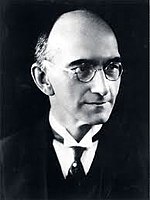Paul Rivet
| Paul Rivet. | |
|---|---|

Paul Rivet
|
|
| Born | 7 May 1876 Wasigny, Ardennes |
| Died | 21 March 1958 (aged 81) |
| Nationality | French |
| Fields | ethnology |
| Known for |
Musée de l'Homme Comité de vigilance des intellectuels antifascistes |
Paul Rivet (7 May 1876, Wasigny, Ardennes – 21 March 1958) was a French ethnologist; he founded the Musée de l'Homme in 1937. In his professional work, Rivet is known for his theory that South America was originally populated in part by migrants who sailed there from Australia and Melanesia. He got married with Mercedes Andrade Chiriboga, a woman born in Cuenca, Ecuador.
Paul Rivet was born in Wasigny, Ardennes in 1876. He attended local schools and university, studying to be a doctor.
Trained as a physician, in 1901 he took part in the Second French Geodesic Mission for survey measurements of the length of a meridian arc to Ecuador. He remained for five years in South America, where he was mentored by Federico González Suárez, an Ecuadorian bishop, historian and archaeologist. Rivet became interested in the indigenous peoples, beginning an ethnographic study of the Huaorani people of the Ecuadorian Amazon, then known as the Jívaro. Returning to France, Rivet went to work with the Muséum national d'histoire naturelle, directed by René Verneau.
He published several papers on his Ecuadorian research, before publishing an extended volume co-authored with René Verneau, titled Ancient Ethnography of Ecuador (1921-1922). In 1926, Rivet participated in founding the Institut d'ethnologie in Paris, together with Marcel Mauss, Emile Durkheim, and Lucien Lévy-Bruhl. They intended it as a collaboration among the fields of philosophy, ethnology and sociology. He taught many French ethnologists, including George Devereux. In 1928, he succeeded René Verneau as director of the National Museum of Natural History.
...
Wikipedia
